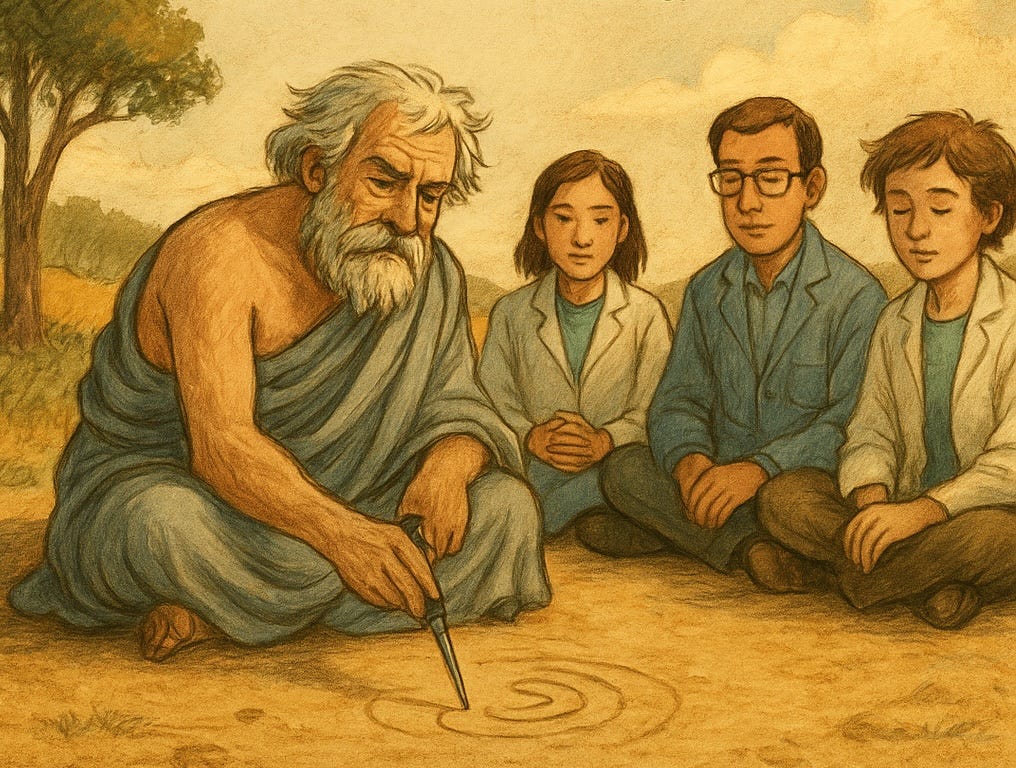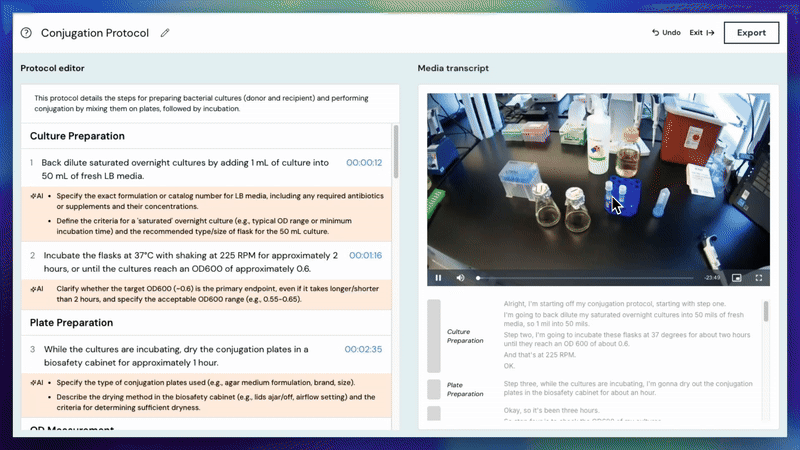PRISM: Capturing the Invisible Art of Scientific Practice
A New Tool for Recording and Scaling Laboratory Expertise
The Lab Lore Problem
We've all been there. You find a promising protocol buried in the methods section of a paper. You follow it precisely - or so you think - yet somehow your results look nothing like what was published. The authors wrote "cells were gently resuspended," but what exactly constitutes "gentle"? They wrote "incubate until turbid," but failed to mention the specific visual cues they used to judge turbidity under their particular lighting conditions. These gaps aren't oversights—they're the inevitable result of trying to compress embodied knowledge into text.
At Cultivarium, we're working with nearly 500 different microbes, many of which have their own unique requirements. For example, some require precise wavelengths of light to thrive; others need specific gas mixtures; some aggregate in ways that confound standard protocols. When you're engineering organisms that have never seen the inside of a traditional lab, you quickly discover that the scientific literature, for all its rigor, simply cannot capture the full art of laboratory practice.
To address this challenge, we have leveraged Large Language Model (LLM)-based tools that organize and synthesize the vast, fragmented landscape of microbiological methods literature. Our internal LLM-based knowledge stack has helped us bootstrap our work across a wide range of organisms, revealing how different labs approach similar problems. But even the most advanced language models can't extract knowledge that was never written down.
This shouldn’t come as a surprise- scientific papers are narratives, crafted to tell compelling stories within the constraints of academic publishing. They represent filtered versions of reality, shaped by publication bias, word limits, and the need to present messy experimental journeys in a clean narrative. While the recent advancements in AI reasoning agents for science are intriguing resources for parsing scientific literature, a critical bottleneck remains upstream of the process: documentation.
So how do we document better? As an initial step, we added a "Lab Lore" section on the Cultivarium Portal. This section serves as a digital repository for the sticky notes that accumulate in every lab notebook, capturing the tricks and insights that never make it into publications. But we've come to realize this isn't enough. There are simply too many nuances that resist textual description, such as the angle at which you hold a pipette when working with aggregating cells, the subtle color change that signals the perfect moment to stop a reaction, and the rhythm of mixing that prevents foam formation in a particular medium. These are the kinds of tacit knowledge that can take months or years to transfer between scientists, if it ever happens at all.
Introducing PRISM: Protocol Recording for Improved Scientific Methodology
Today, we're announcing beta access to PRISM, an AI-powered lab assistant that captures what experimentalists actually see and do in the laboratory. With cutting-edge LLMs, PRISM transforms the traditional protocol from a static text document into a rich, multimodal record of scientific practice.
Here's how it works: Before beginning an experiment, a scientist dons a pair of glasses that capture both audio and visual data. As they work, they narrate their actions by calling out key observations. PRISM then processes this raw footage, converting it into a step-by-step protocol. The software highlights any missing details and synchronizes the video with each step of the protocol. Users can then edit and fine-tune the output, assisted by AI suggestions.
The result is a detailed multimodal protocol that others can read, listen to, and watch to see how an expert handles each step. When a protocol says "resuspend cells," viewers can observe the precise pipetting technique. When it mentions checking for contamination, they can see what contamination actually looks like in that specific experimental context.
PRISM captures science as it actually happens, including the failures, the adjustments, and the intuitive decisions that experienced researchers make without conscious thought.
Why Now? The Convergence of Need and Capability
As a non-profit, Cultivarium occupies a unique position in the scientific ecosystem. Unlike commercial entities driven by immediate profit considerations, we have the freedom to take a longer-term approach and collaborate with the scientific community to determine what is genuinely needed. Our goal is to address fundamental research challenges through our own experience while actively collaborating with the broader scientific community for input and co-development.
PRISM represents the first module in what we envision as a comprehensive suite of tools for capturing and scaling scientific expertise. But it's also immediately useful. For anyone working with non-model organisms, where every technique must be adapted or invented, PRISM offers a way to document and share hard-won methodological insights. For collaborations between labs, it provides a richer medium for knowledge transfer than any methods section could achieve. For education, it opens up new possibilities for training the next generation of scientists in techniques that have traditionally required extensive hands-on mentorship.
The Future of Laboratory Automation
While PRISM's immediate value lies in better documentation and knowledge sharing, we see it as laying crucial groundwork for a more ambitious goal. Most current laboratory automation focuses on scaling up established processes - taking something that works and doing it 100 or 1,000 times. But what about automating actual R&D, the kind that goes from 0 to 1?
We believe that recording a raw feed of scientific practice is essential for developing genuine artificial intelligence for science. Parsing literature is valuable for understanding what has been tried, and for drawing connections between disparate findings. However, we scientists know that papers shaped by publication pressures often portray successful outcomes, rather than the countless micro-decisions and adaptations that made success possible.
By capturing the ground truth of laboratory work – the false starts, the on-the-fly adjustments, the visual and tactile cues that guide expert judgment – PRISM defines a new kind of training data for science. This data could eventually enable AI systems that not only execute predefined protocols, but can also adapt to the unexpected, recognize when something isn't working, and even generate novel approaches to experimental challenges.
JOIN US: A Call for Collaboration
PRISM works today. We're using it in our labs to capture protocols for our diverse microbial collection, building the foundation for a new kind of scientific knowledge base. However, we designed it to be larger than the Cultivarium team.
The PRISM tool we’re making accessible today is not the final product - it is the beginning of an R&D process that is better done in collaboration. We're actively seeking partners and co-developers who want to help expand PRISM beyond our initial use cases, and build the vision and action models for the laboratory. If you're passionate about shaping how science is taught, shared, and automated in the coming decades, we want to hear from you. Contact us to explore collaboration opportunities, request early access, or share your vision for the future of scientific methodology.
We’re looking to work with:
Research groups working with challenging organisms or protocols
Institutions focused on reproducibility and training
Educators interested in new ways to teach laboratory skills
Data scientists/ML experts with ideas for enhancing PRISM's capabilities
Scientists frustrated by the limitations of written protocols
Funding organizations supporting reproducibility and scientific methods development
Science communicators seeking to fundamentally transform how we share scientific knowledge.
We're particularly interested in feedback on:
Protocol types that would benefit most from multimodal capture
Integration with existing laboratory workflows
Features that would make PRISM indispensable for your research
Novel applications we haven't considered
From an Art to a Science
The scientific challenges we face, from understanding microbial dark matter to engineering biology for sustainability, require new approaches to working. They need us to move beyond the limitations of text-based knowledge transfer and embrace richer forms of scientific communication, because – despite our best efforts – sometimes great science falls into the gaps between what we write and what we do.
It is time to patch up these gaps. The countless small expertises that make discovery possible should no longer be lost between the sections of our publications. By recording and indexing experiments for deeper study by both humans and machines, we can avoid the false dichotomy between glorifying human taste and holding our breath for artificial superintelligence. The way forward is about augmenting, not replacing human expertise. Together, we can move the art of science to a science.
Access PRISM here, or book a demo.
Stay tuned for the next part of this series. As we continue to develop PRISM, we'll also dive deeper into our roadmap for revolutionizing laboratory R&D through true 0-to-1 automation. it's not about repackaging existing automation platforms, but reimagining how artificial intelligence can participate in the creative process of scientific discovery.





Love it. Sending you an email now
This is awesome, have thought someone should build this:)